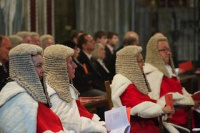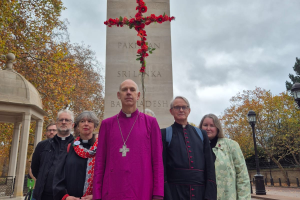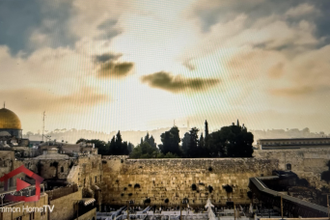Westminster: Red Mass - lawyers called to be compassionate

Bishop Nicholas Hudson celebrated the annual Mass for members of the legal profession at Westminster Cathedral this morning, 1 October 2014. Other celebrants included Canon lawyers and members of the tribunal, including Mgr John Conneely, the Judicial Vicar for the diocese. They were joined on the sanctuary by Anglican guests.
In his homily, Bishop Nicholas spoke about the role of compassion in the justice system, which retains the dignity and hope of those they serve:
‘As lawyers, you are, of course, called to examine thoroughly the evidence, to gather all the relevant facts, to argue your case, to act always with justice. But the Pope’s words remind us there is always a place for compassion within this process; compassion and that spirit of mercy which allows those who stand before you to retain their dignity and their hope.’
Bishop Nicholas also reflected on the immense mercy shown in the parable of Prodigal Son:
‘Luke records for us the fantastically prodigal mercy bestowed by a father on a son who has squandered all: a father who goes out to the edges of his estate to look for the son who has spent all his inheritance on a life of debauchery. Mercy is all that the father expresses when the older son protests: “My son,” he says to him, “you are with me always and all I have is yours. But it is only right that we should celebrate and rejoice, because your brother here was dead and has come to life; he was lost and is found.”’
Before the Reformation, the judiciary and legal profession gathered at Westminster Abbey to call upon the Holy Spirit to guide it in its work for the coming legal year. The custom of the Red Mass was revived in 1891, and received full official recognition in 1898, in the presence of the Lord Chief Justice, and Cardinal Vaughan presiding. It has been celebrated in Westminster Cathedral since 1904.
A full copy of Bishop Nicholas Hudson’s homily follows below:
Westminster Cathedral 1st October 2014
We pray in this Mass for the Holy Spirit to come upon us anew. For we need him to remind us of all that Jesus said to us. One of the most important things that Jesus taught us - we remind ourselves of in every Mass: to forgive those who trespass against us, that we might also be forgiven our trespasses. The Spirit reminds us how Jesus forgave; that he showed God’s way of forgiving is mercy.
It was Pope Francis who pointed this out in a homily he preached last Lent on the woman caught in adultery. This story, he said, shows us that God’s way of forgiving is mercy; that God’s way of forgiving is mercy. “He doesn’t humiliate her,” says the Pope, “He doesn’t say, ‘What have you done? When did you do it? How did you do it? With whom did you do it?’ No! He says, ‘Go and do not sin again’.” He reminds us to feel compassion, first and foremost, for the person who is under the scrutiny of the law.
As lawyers, you are, of course, called to examine thoroughly the evidence, to gather all the relevant facts, to argue your case, to act always with justice. But the Pope’s words remind us there is always a place for compassion within this process; compassion and that spirit of mercy which allows those who stand before you to retain their dignity and their hope.
It’s been said God’s very first act, the primordial act, of mercy was his compassionate clothing of the naked Adam and Eve. Isaiah emphasises the Lord’s mercy when he reminds us that ours is a God who “does not break the crushed reed”. Then, of course, Luke records for us the fantastically prodigal mercy bestowed by a father on a son who has squandered all: a father who goes out to the edges of his estate to look for the son who has spent all his inheritance on a life of debauchery. Mercy is all that the father expresses when the older son protests: “My son,” he says to him, “you are with me always and all I have is yours. But it is only right that we should celebrate and rejoice, because your brother here was dead and has come to life; he was lost and is found.”
Then Jesus himself shows extraordinary mercy as the lifeblood drains out of him on Calvary: “Father, forgive them, they know not what they do.” Mercy is all he bears in his heart as he comes to be with the Twelve on the evening after he has risen. Showing his hands and his side to them, he says, “Peace be with you. Receive the Holy Spirit. For those whose sins you forgive, they are forgiven; for those whose sins you retain, they are retained.”
Where I trained for the priesthood at the English College in Rome we prayed daily beneath a most powerful image of mercy. The picture is known as the Martyrs’ Picture. It shows God the Father raising up the body of the crucified Christ, the Holy Spirit hovering between them in the form of a dove. It was commissioned for the opening of the College in 1580, a College which produced some forty-four martyrs in the first century of its existence. It’s called the Martyrs’ Picture because whenever the students received news that one of their brothers had been killed, they would come together to sing a Te Deum before this image. I like to think that some of those who made the supreme sacrifice recalled that image as they mounted the scaffold at Tyburn over by Marble Arch and derived succour from it.
It is the most powerful depiction of mercy. The Father’s reception into his lap of his Son’s bruised and battered body is the most beautiful representation of the Mercy Seat that I know. St John Paul II’s saying in Dives in Misericordia comes to mind: that the Father’s raising of the Son is another primordial act of mercy. The poignancy of this image was deepened when it was recently restored; and removing four hundred years of grime revealed that the artist had placed over the Father’s hands the most delicate muslin cloth: a statement of the honour with which the Father receives the Body of His Son.
The merciful spirit with which this painting had endued the hearts of the College’s first priests finds expression in the deeply poignant letters penned by the first martyr, the College’s protomartyr, St Ralph Sherwin. He writes from the Tower to his uncle: “This very day I was informed … that tomorrow I was to end the course of this life. My sins are great, I confess, but I flee to God’s mercy: I have no boldness but in his blood … the prophet hath recorded that he hath written us in His hands … I appeal to my Redeemer’s clemency. Prayers for my soul procure me, my loving patron: and so, having great need to prepare myself for God, never quieter in mind nor less troubled towards God … I bid you farewell.”
He said very little on the scaffold.
He praised each person of the Trinity. I like the fact that he then chose to smoke a last pipe, nodding towards to sun, saying to his companion, “Ah, Mr Campion, tonight we shall be above yonder fellow.”
He then forgave all who were responsible for his death: “I forgive all,” he said, “who, either by general presumption or particular error, have procured my death.” He prayed for the Queen. Echoes of his own Master’s death; echoes of “Father, forgive them”. He had clearly meditated on the manner of his own Master’s dying; remembered well how the Lord had gone to his death; and followed him there with consummate grace.
We sometimes contrast, these days, Red and White Martyrdom: to say that this red martyrdom of the 16th and 17th centuries is complemented by the white martyrdom of the intervening ones. By this I mean the countless men and women who suffered for the faith without being martyred but still edify and encourage by their example.
I find myself thinking today of St Therese of Lisieux whose Feast it is today. She articulates God’s mercy with an eloquence which is extraordinarily moving, an eloquence and simplicity which explain why she is a Doctor of the Church.
She gave the most moving expression to her faith in God’s mercy in the last months of her life, when she was asked to correspond with a young missionary priest by the name of Maurice. You can read for yourself their beautiful letters in Maurice and Therese – a Love: I don’t know anyone who has read it and not been deeply touched. As the life is draining out of her, Therese tells Maurice by letter - they never met – that she will soon go to God; and that she has left for him certain precious items, like her crucifix. She bids him farewell and promises to pray for him from heaven. We understand this to be their last communication.
But Maurice can’t help himself writing one final letter in which he expresses all the angst that is within him: “What I find most difficult to bear is the thought that you will see, from heaven, just how bad I am; what a sinner I have been; what a poor priest I make.”
By this time Therese is bed-ridden. But she makes a supreme effort to raise herself and write one last letter in which she addresses him in the tenderest way: “Dearest, dearest Maurice, you must not feel such anguish; you have to believe that, when I am in heaven, I shall look on you with all the compassion that is in the Father’s heart.”
“I shall share with you in the infinite mercy of the Lord.” She reminds him that God’s way of forgiving is mercy.


















